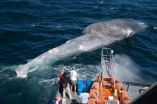(Press-News.org) NEWPORT, Ore. -- A comprehensive 15-year analysis of the movements of satellite-tagged blue whales off the West Coast of the United States found that their favored feeding areas are bisected by heavily used shipping lanes, increasing the threat of injury and mortality.
The researchers note that moving the shipping lanes off Los Angeles and San Francisco to slightly different areas – at least, during summer and fall when blue whales are most abundant – could significantly decrease the probability of ships striking the whales. A similar relocation of shipping lanes in the Bay of Fundy off eastern Canada lowered the likelihood of vessels striking endangered right whales an estimated 80 percent.
Results of the study – which was supported by the Office of Naval Research, the National Geographic Society, the National Science Foundation, private gifts to the Oregon State University Marine Mammal Institute and others – are being published this week in the journal PLOS ONE.
The analysis is the most comprehensive study of blue whales movements ever conducted. It was led by researchers at Oregon State University's Marine Mammal Institute, who tracked the movement of blue whales off the West Coast to identify important habitat areas and environmental correlates, and subsequently to understand the timing of their presence near major ports and shipping traffic.
"The main areas that attract blue whales are highly productive, strong upwelling zones that produce large amounts of krill – which is pretty much all that they eat," said Ladd Irvine, a researcher with OSU's Marine Mammal Institute and lead author on the PLOS ONE study. "The whales have to maximize their food intake during the summer before they migrate south for the winter, typically starting in mid-October to mid-November."
"It appears that two of their main foraging areas are coincidentally crossed by shipping lanes," Irvine added.
In their study, the researchers attached transmitters to 171 blue whales off California at different times between 1993 and 2008 and tracked their movements via satellite. Their study looked at seasonal as well as individual differences in whale distribution, documenting a high degree of variability – but also a strong fidelity to the upwelling zones that coincide with ship traffic to and from the major ports of Los Angeles and San Francisco.
Blue whales can grow to the length of a basketball court, weigh as much as 25 large elephants combined, and their mouths could hold 100 people, though their diet is primarily krill – tiny shrimp-like creatures less than two inches in length. The blue whale is the largest creature to ever inhabit the Earth, yet little was known about their range or where they went to breed until Oregon State's Bruce Mate led a series of tracking studies featured in the popular 2009 National Geographic documentary, "Kingdom of the Blue Whale."
An estimated 2,500 of the world's 10,000 blue whales spend time in the waters off the West Coast of the Americas and are known as the eastern North Pacific population. The huge whales can travel from the Gulf of Alaska all the way down to an area near the equator known as the Costa Rica Dome.
The majority of the population spends the summer and fall in the waters off the U.S. West Coast, with the areas most heavily used by the tagged whales occurring off California's Santa Barbara and San Francisco, which puts them in constant peril from ship strikes.
"During one year, while we were filming the documentary, five blue whales were hit off of southern California during a seven-week period," said Mate, who directs the Marine Mammal Institute at OSU's Hatfield Marine Science Center in Newport, Ore. "Blue whales may not be as acoustically aware as species that rely on echolocation to find prey and there is some evidence that the location of the engines in the rear of the ship creates something of an acoustic shadow in front of them, making it hard for whales to hear the ship coming.
"Putting some kind of noise deterrent on the ships isn't really an option, however," Mate added. "You don't really want to drive endangered whales out of their prime habitat and best feeding locations."
Moving the shipping lanes would not be unprecedented, the researchers note. Scientists brought concerns about right whale ship strikes in the Bay of Fundy to the International Maritime Organization, and the industry led the effort to modify shipping lanes in the North Atlantic more than a decade ago.
Daniel Palacios, also a co-author on the paper and a principal investigator with OSU's Marine Mammal Institute, said vessel traffic between Santa Barbara and Los Angeles moved south of its current location in the past to comply with the California Clear Air Act, but shifted back to its current location after getting an exemption to the legislation.
"It is not often that research results are so applicable to a policy decision." Palacios said, "It's not really our place to make management decisions, but we can inform policy-makers and in this case it is pretty straightforward. You will eliminate many of the ship strikes on blue whales by moving the shipping lanes south of the northern Channel Islands."
The solution for the San Francisco area is similar, the researchers note, though not quite as simple. Three separate shipping lanes are used in the region and all cross through the home range and core areas of blue whales tagged in this study.
"We did find that the northernmost shipping lanes crossed the area that was most heavily used by tagged whales," Irvine noted. "Restricting use of the northern lane during the summer and fall when more whales are present is one option; another would be to extend one lane further offshore before separating it into different trajectories, minimizing the overlap of the shipping lanes with the areas used by blue whales."
The National Oceanic and Atmospheric Administration is planning a review of shipping lanes in the southern California area, which will be informed by this study. A variety of stakeholders must be consulted, however, before any changes are implemented.
INFORMATION:
Other funding sources for this study over the years including the TOPP Program (Tagging of Pacific Pelagics), the OSU Marine Mammal Institute Endowment, the Alfred P. Sloan Foundation, the Packard Foundation, NASA, the U.S. Geological Survey, the National Park Service, U.S. Fish and Wildlife Service and the Smithsonian Institution.
15-year analysis of blue whale range off California finds conflict with shipping lanes
2014-07-24
ELSE PRESS RELEASES FROM THIS DATE:
Greater odds of adverse childhood experiences in those with military service
2014-07-24
Bottom Line: Men and women who have served in the military have a higher prevalence of adverse childhood events (ACEs), suggesting that enlistment may be a way to escape adversity for some.
Authors: John R. Blosnich, Ph.D., M.P.H., of the Veterans Affairs Pittsburgh Healthcare System, and colleagues.
Background: The prevalence of ACEs among U.S. military members and veterans is largely unknown. ACEs can result in severe adult health consequences such as posttraumatic stress disorder, substance use and attempted suicide.
How the Study Was Conducted: Authors compared ...
Enhanced recovery program following colorectal surgery at community hospitals
2014-07-24
Bottom Line: An enhanced recovery program for patients after colorectal surgery appears to be feasible in a community hospital setting after having been shown to be successful in international and academic medical centers.
Author: Cristina B. Geltzeiler, M.D., of Oregon Health and Science University, Portland, and colleagues.
Background: The fundamental aspects of enhanced recovery after surgery (ERAS) programs are guidelines that focus on patient education, optimal fluid management, minimal incision length, decreased use of tubes and drains, opioid-sparing analgesia, ...
Study examines postoperative pneumonia prevention program in surgical ward
2014-07-24
Bottom Line: A postoperative pneumonia prevention program for patients in the surgical ward at a California Veterans Affairs hospital lowered the case rate for the condition, which can cause significant complications and increase the cost of care.
Author: Hadiza S. Kazaure, M.D., of the Stanford University School of Medicine, California, and colleagues.
Background: Pneumonia is a common infection that accounts for about 15 percent of all hospital-acquired infections and as much as 3.4 percent of complications among surgical patients.
How the Study Was Conducted: The ...
New regions of genetic material are involved in the development of colon cancer
2014-07-24
Most research on human cancer genes have been focused on the regions of the coding genome (exons) that are to be translated in the form of amino acids thus proteins. But just before each gene, there is a regulatory region or activator which controls the expression and activity of the adjacent gene. Until now, very little was known of the role exerted such DNA fragment in tumor development.
An article published today in Nature in collaboration with the group of Manel Esteller, Director of Epigenetics and Cancer Biology, Bellvitge Biomedical Research Institute (IDIBELL), ...
Nano-sized chip 'sniffs out' explosives far better than trained dogs
2014-07-24
Security forces worldwide rely on sophisticated equipment, trained personnel, and detection dogs to safeguard airports and other public areas against terrorist attacks. A revolutionary new electronic chip with nano-sized chemical sensors is about to make their job much easier.
The groundbreaking nanotechnology-inspired sensor, devised by Prof. Fernando Patolsky of Tel Aviv University 's School of Chemistry and Center for Nanoscience and Nanotechnology, and developed by the Herzliya company Tracense, picks up the scent of explosives molecules better than a detection dog's ...
Detecting concussion-related brain disease in its earliest stages
2014-07-24
Autopsies have shown that some high-profile athletes who suffered repeated blows to the head during their careers have unusual protein clumps in their brains. Those clumps suggest the athletes had a disease called chronic traumatic encephalopathy (CTE). Now, scientists are working on tests that might be able to detect CTE in its earliest stages, according to an article in Chemical & Engineering News (C&EN), the weekly news magazine of the American Chemical Society.
In the article, Lauren Wolf, a senior editor at C&EN, explains that many of these athletes struggled with ...
Dead-body-feeding larvae useful in forensic investigations
2014-07-24
VIDEO:
This image depicts Chrysomya megacephala larvae on decomposing fish.
Click here for more information.
Non-biting blow fly Chrysomya megacephala is commonly found in dead bodies and is used in forensic investigations to determine the time of death, referred to as the post mortem interval. A report of synanthropic derived form of C. megacephala from Tamil Nadu is provided for the first time based on morphological features and molecular characterization through generation ...
Nearly 50 years of lemur data now available online
2014-07-24
VIDEO:
Duke Lemur Center had made 48 years of primate data available online.
Click here for more information.
DURHAM, N.C. -- A 48-year archive of life history data for the world's largest and most diverse collection of endangered primates is now digital and available online. The Duke Lemur Center database allows visitors to view and download data for more than 3600 animals representing 27 species of lemurs, lorises and galagos -- distant primate cousins who predate monkeys ...
New mass map of a distant galaxy cluster is the most precise yet
2014-07-24
Astronomers using the NASA/ESA Hubble Space Telescope have mapped the mass within a galaxy cluster more precisely than ever before. Created using observations from Hubble's Frontier Fields observing programme, the map shows the amount and distribution of mass within MCS J0416.1-2403, a massive galaxy cluster found to be 160 trillion times the mass of the Sun. The detail in this mass map was made possible thanks to the unprecedented depth of data provided by new Hubble observations, and the cosmic phenomenon known as strong gravitational lensing.
Measuring the amount and ...
University of Delaware researcher describes new approach for creating organic zeolites
2014-07-24
Yushan Yan, Distinguished Professor of Engineering at the University of Delaware, is known worldwide for using nanomaterials to solve problems in energy engineering, environmental sustainability and electronics.
His early academic work focused on zeolites, porous rock with a well-defined, crystalline structure. At the atomic scale, their pore size is so precisely decided that zeolites can separate molecules with size differences of merely a fraction of an angstrom (one-tenth of a nanometer), making them useful to the chemical and petroleum industries as molecular sieves ...




